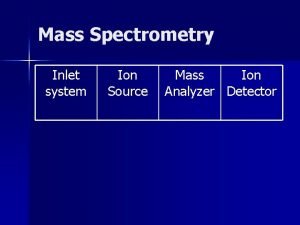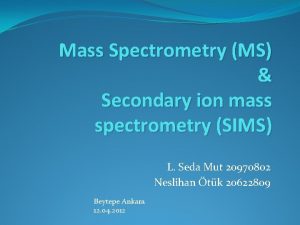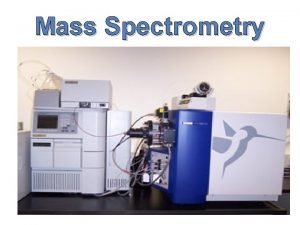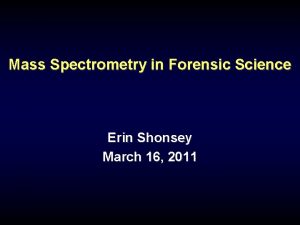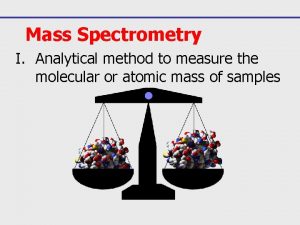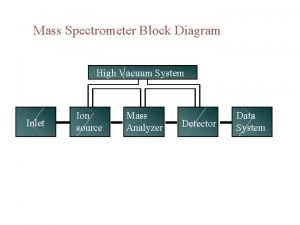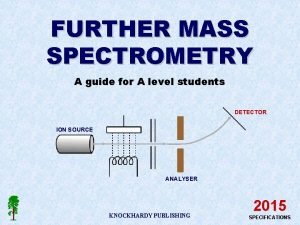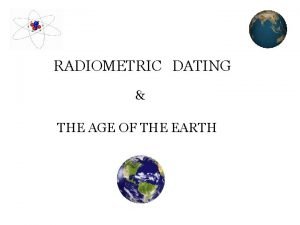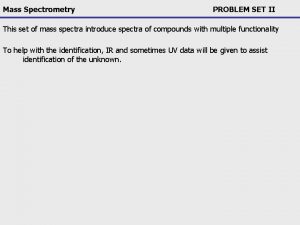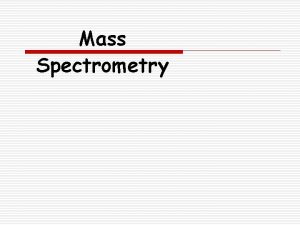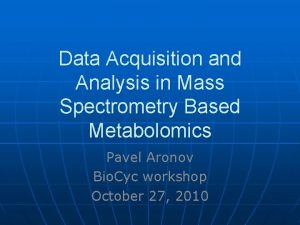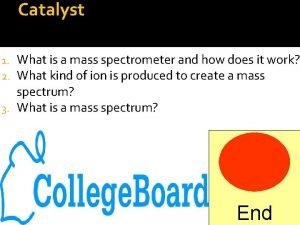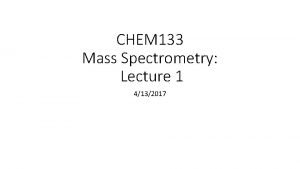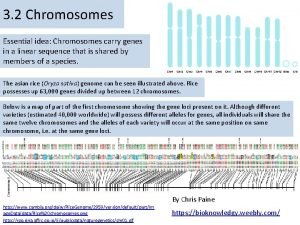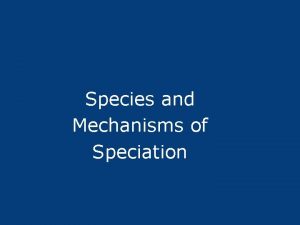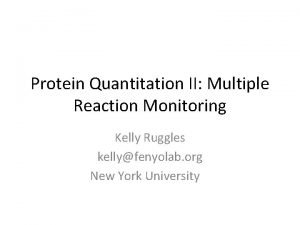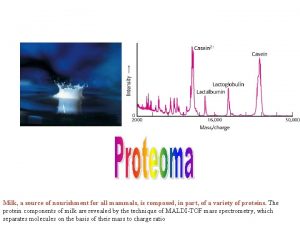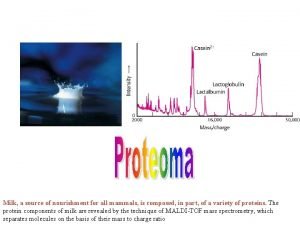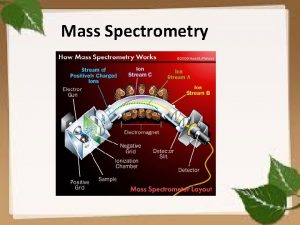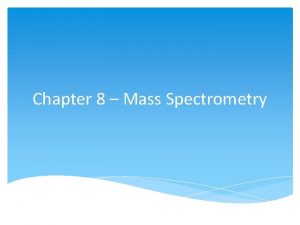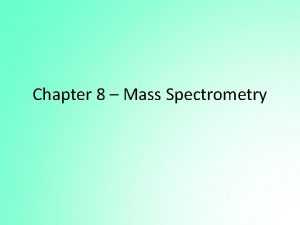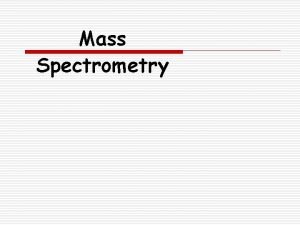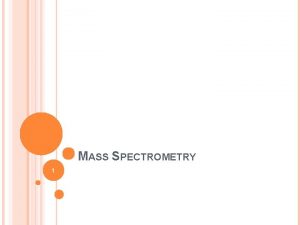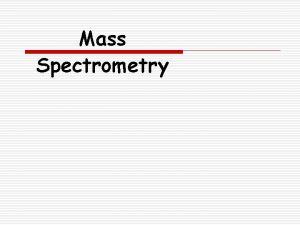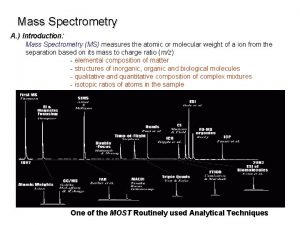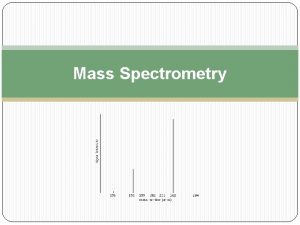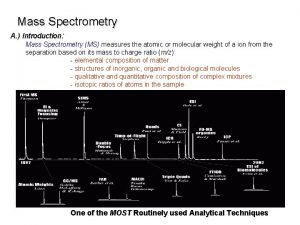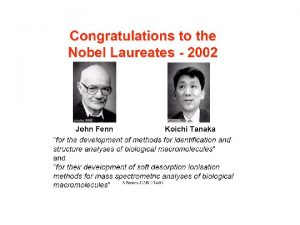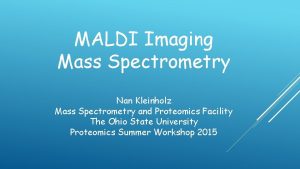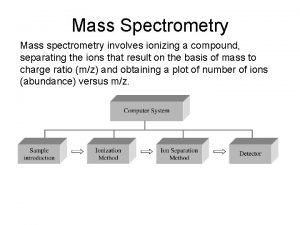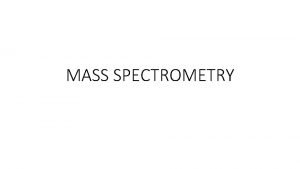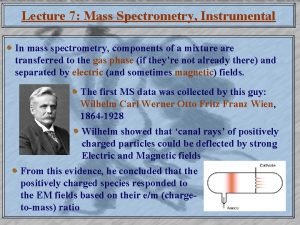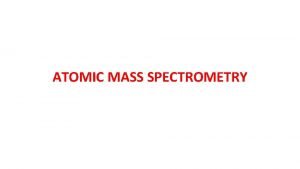Mass Spectrometry Inlet system Ion Source Mass Ion




















- Slides: 20

Mass Spectrometry Inlet system Ion Source Mass Ion Analyzer Detector

Mass Analyzers Which one is best for a given application? Depends on resolution (separating power of mass spectrometer) For two peaks m and m+Dm resolution is: m/Dm MW of C 16 H 22 O 2 and C 17 H 26 O ? Resolution required?

Types of Mass Analyzers Focuses based on momentum Magnetic Sector: Single Focusing: A magnetic field is used to focus ions based on their momentum as they are ejected from an ion source at high energy. Resolution <2000

Magnetic sector double focusing: An electrostatic analyzer is used serially with a magnet to select monoenergetic ions. High resolution >10, 000 mass up to 100, 000 Da

Quadrupole: electronic mass filter that selects ions of a single m/z by superimposing a radio frequency and a direct current potential Unit mass resolution mass range to approximately 2000 most common detector coupled to GC systems

Time of Flight Measures all m/z simultaneously

Ion Trap RF fields yield m/z band of stability • 3 D RF Fields • Detect those ions that are selectively ejected due to destabilized trajectory n Quadrupole n


FT-ICR (Fourier Transform Ion Cyclotron Resonance) Advantages of FT: 1. 2. 3. 4. Improved S/N Greater speed per spectrum Higher sensitivity Greater resolution

FT-ICR

FT-ICR n Animation: http: //info. med. yale. edu/wmkeck/proc hem/fticr/FTICR. mpg

Mass Spectrometry Inlet system Ion Source Mass Ion Analyzer Detector

Inlet Systems n Purpose is to introduce a very small amount of sample into the mass spectrometer so that its components may be converted into gas ions Want minimal loss of vacuum

Direct Probe Inlet n n n Good for solid and nonvolatile liquids Sample is on surface, probe positioned near ionization source and slit leading to spectrometer Good for low concentrations or thermally unstable compounds

Mass Spectrometry Inlet system Ion Source Mass Ion Analyzer Detector

Detectors for MS n n n Need to be very sensitive Typical gains are 10^5 up to 10^8! Provides high current with nanosecond response time Continuous Dynode

Mass Spectrometry Summary 1. 2. 3. MS is the ultimate in a qualitative analysis tool! MS by itself is most useful for analyzing pure compounds Analyte in mixture requires MS to be hyphenated to another technique For ex. GC-MS, LC-MS, MS-MS, or CE-MS

Advantages of MS 1. 2. Detection limits up to 3 orders of magnitude better than optical methods Remarkably simple spectra that are usually unique and easily interpretable

Disadvantages of MS 1. 2. 3. Instrument costs 2 -3 x higher than optical atomic instruments Instrument drift can be as high as 5 -10% per hour Subject to interferences

TONS of applications! n n Regiospecific Analysis of Diricinoleoylacylglycerols in Castor (Ricinus communis L. ) Oil by Electrospray Ionization-Mass Spectrometry Characterization of Puff-by-Puff Resolved Cigarette Mainstream Smoke by Single Photon Ionization-Timeof-Flight Mass Spectrometry and Principal Component Analysis Electrospray Ionization Mass Spectrometry Fingerprinting of Brazilian Artisan Cachaça Aged in Different Wood Casks Determination of Nitrofuran Residues in Milk of Dairy Cows Using Liquid Chromatography-Tandem Mass Spectrometry
 Inlet system in mass spectrometry
Inlet system in mass spectrometry Principle of mass spectrophotometer
Principle of mass spectrophotometer Ion mobility spectrometry
Ion mobility spectrometry Lc-ms schematic diagram
Lc-ms schematic diagram Mass spectrometry graph
Mass spectrometry graph Mass spectrometry in forensic science
Mass spectrometry in forensic science Quadrupole mass analyzer
Quadrupole mass analyzer Mass spectrometer block diagram
Mass spectrometer block diagram Mass
Mass Accelerator mass spectrometry
Accelerator mass spectrometry Mass spectrometry problem set
Mass spectrometry problem set Sdbsweb
Sdbsweb Mass spectrometry data acquisition for gc/ms
Mass spectrometry data acquisition for gc/ms Khan academy mass spectrometry
Khan academy mass spectrometry Past paper
Past paper Mass spectrometry lecture
Mass spectrometry lecture Mass spectrometry
Mass spectrometry Assortative
Assortative Swath mass spectrometry
Swath mass spectrometry Mass spectrometry
Mass spectrometry Mass spectrometry
Mass spectrometry
